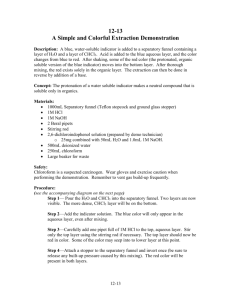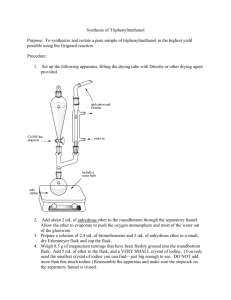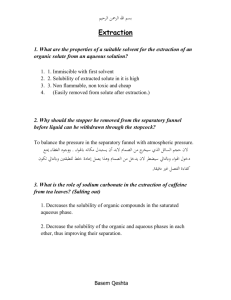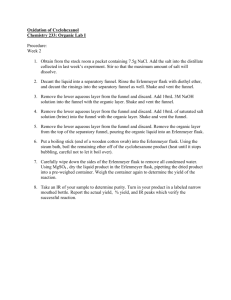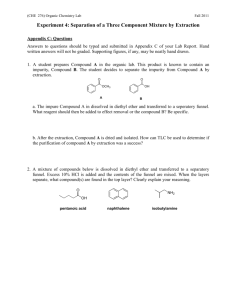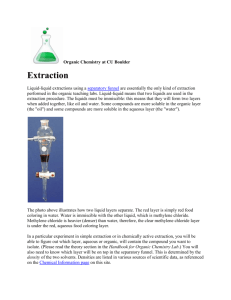Discussion Comments - Chemistry Courses: About
advertisement
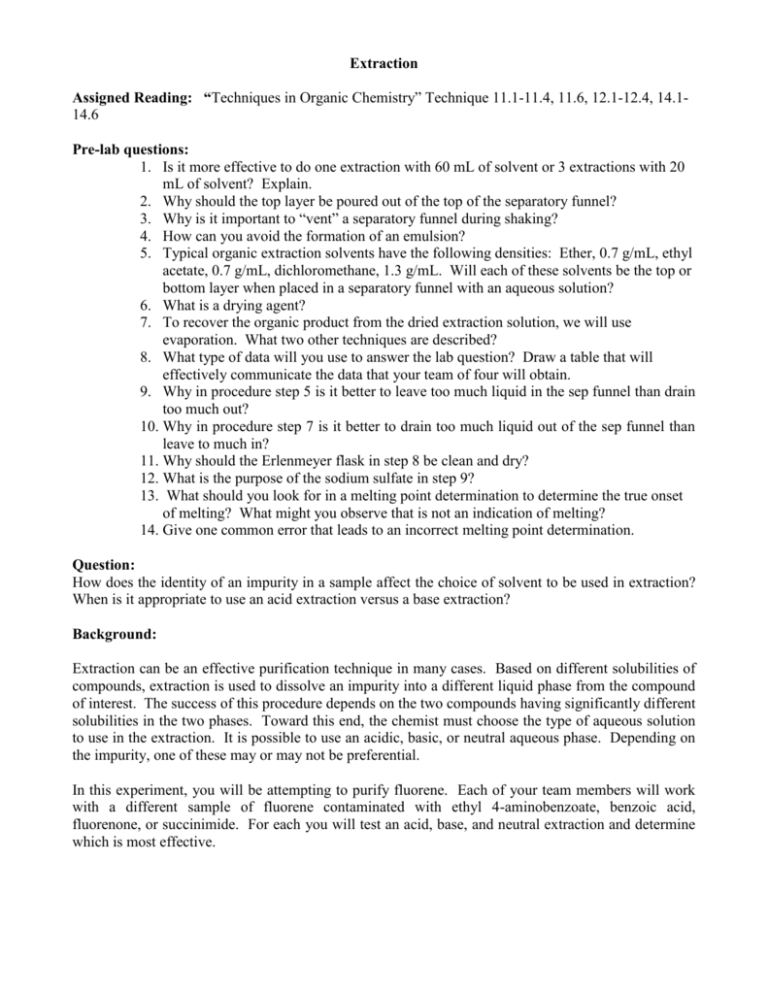
Extraction Assigned Reading: “Techniques in Organic Chemistry” Technique 11.1-11.4, 11.6, 12.1-12.4, 14.114.6 Pre-lab questions: 1. Is it more effective to do one extraction with 60 mL of solvent or 3 extractions with 20 mL of solvent? Explain. 2. Why should the top layer be poured out of the top of the separatory funnel? 3. Why is it important to “vent” a separatory funnel during shaking? 4. How can you avoid the formation of an emulsion? 5. Typical organic extraction solvents have the following densities: Ether, 0.7 g/mL, ethyl acetate, 0.7 g/mL, dichloromethane, 1.3 g/mL. Will each of these solvents be the top or bottom layer when placed in a separatory funnel with an aqueous solution? 6. What is a drying agent? 7. To recover the organic product from the dried extraction solution, we will use evaporation. What two other techniques are described? 8. What type of data will you use to answer the lab question? Draw a table that will effectively communicate the data that your team of four will obtain. 9. Why in procedure step 5 is it better to leave too much liquid in the sep funnel than drain too much out? 10. Why in procedure step 7 is it better to drain too much liquid out of the sep funnel than leave to much in? 11. Why should the Erlenmeyer flask in step 8 be clean and dry? 12. What is the purpose of the sodium sulfate in step 9? 13. What should you look for in a melting point determination to determine the true onset of melting? What might you observe that is not an indication of melting? 14. Give one common error that leads to an incorrect melting point determination. Question: How does the identity of an impurity in a sample affect the choice of solvent to be used in extraction? When is it appropriate to use an acid extraction versus a base extraction? Background: Extraction can be an effective purification technique in many cases. Based on different solubilities of compounds, extraction is used to dissolve an impurity into a different liquid phase from the compound of interest. The success of this procedure depends on the two compounds having significantly different solubilities in the two phases. Toward this end, the chemist must choose the type of aqueous solution to use in the extraction. It is possible to use an acidic, basic, or neutral aqueous phase. Depending on the impurity, one of these may or may not be preferential. In this experiment, you will be attempting to purify fluorene. Each of your team members will work with a different sample of fluorene contaminated with ethyl 4-aminobenzoate, benzoic acid, fluorenone, or succinimide. For each you will test an acid, base, and neutral extraction and determine which is most effective. O Fluorene Fluorenone O O O OCH2CH3 OH NH H2N O Benzoic Acid Ethyl 4-Aminobenzoate Succinimide Procedure: 1. Each member of a team of 4 should obtain one of the following impure fluorene samples: fluorene/ethyl 4-aminobenzoate; fluorene/benzoic acid; fluorene/fluorenone; or fluorene/succinimide. (Each sample is a 50/50 mix.) Every team member should have a different impure sample. 2. Place about 0.5 g of your impure sample in 50 mL beaker and record the mass. 3. Obtain about 10-15 mL of ether. Use the ether in small portions to dissolve/suspend the impure mixtue and transfer it to the separatory funnel. (It is ok if it doesn’t all dissolve—just use the ether in small portions to rinse it all into the separatory funnel.) Swirl to dissolve the solid as much as possible. 4. Add 10 mL of distilled water to the separatory funnel. Swirl the separatory funnel, venting often, until thoroughly mixed. All solid should be dissolved at this time. If it is not, add 2 mL of ether and 2 mL of water, then swirl. Repeat until the sample is dissolved. (Use the least amount of solvent possible!) 5. Drain the bottom layer from the separatory funnel into a beaker or flask. At this stage err in allowing too little liquid out of the separatory funnel rather than too much. Label the flask as either “aqueous layer” or “organic layer”. (Which is it?!) 6. Add a second 10 mL portion of distilled water to the separatory funnel. Shake the separatory funnel, venting often, until thoroughly mixed. 7. Drain the bottom layer from the separatory funnel into the same beaker or flask from step 5. At this stage err in allowing too much liquid out of the separatory funnel rather than too little. 8. Pour the top layer out the top of the separatory funnel into a clean, dry 50 mL Erlenmeyer flask. Rinse the separatory funnel out with ~5 mL of ether and transfer this to the Erlenmeyer as well. 9. Dry the ether with sodium sulfate for at least 5 minutes. Decant the ether solution into a clean, dry beaker. (What would happen if you pour the sodium sulfate into the beaker too?) Rinse the sodium sulfate remaining in the Erlenmeyer flask with ~5 mL of ether, let this sit for about a minute, and decant the ether into the same beaker. 10. Remove the ether by gently heating with a sand or warm water bath (lowest setting) while blowing nitrogen or air over the warm ether. 11. Transfer the resulting solid to a labeled watch glass. 12. Repeat steps 2-11 two more times, using 1 M HCl and 1 M NaOH in place of distilled water. 13. After the purified fluorene is thoroughly dried, obtain melting point data for each sample. 14. Once you have completed the experiment, give your data to your teammates. You can leave lab after you have all your team’s data. Observations and Results: Include any observations and the melting point data in well-organized table(s). You should clearly indicate which data you collected, and which came from team members. Include names of all team members. Discussion Comments: How can melting point data be useful for indicating the effectiveness of an extraction? Which, if any, extraction method effectively purified fluorene from ethyl 4-aminobenzoate? Provide a chemical explanation for why this extraction method was so effective or why none of the methods was effective. Repeat the same question for the other three impurities. Conclusion: When choosing an extraction solvent for purifying a sample, one should… Reference(s) References for any necessary authentic melting point(s)

